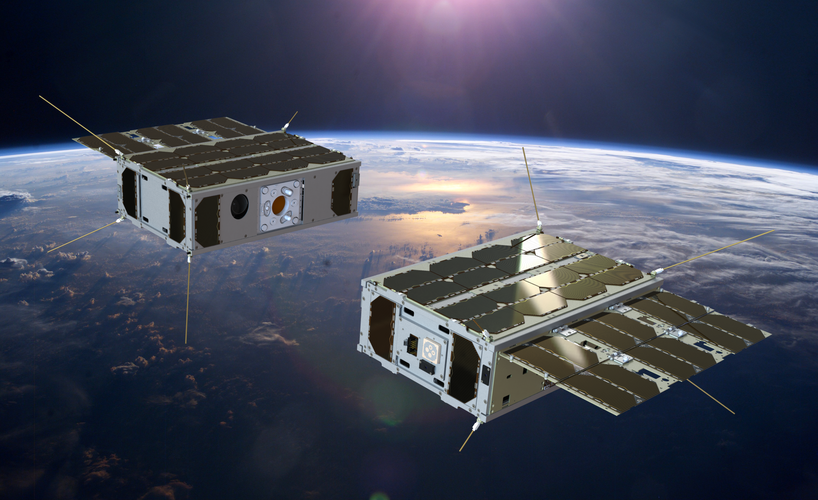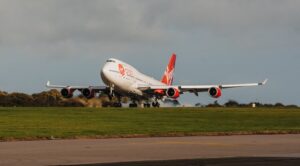SpaceX Transporter-6 successfully launched Europe's first solar sail mission
Monday, 09 January 2023 07:51 Kongsberg NanoAvionics (NanoAvionics) has announced the successful launch of Europe's first solar sail mission aboard SpaceX Transporter-6. The 6U nanosatellite nicknamed 'Alpha' was manufactured for France's Gama. It is one of four satellites, built by the Lithuanian smallsat mission integrator for multiple customers, that got sent into low Earth Orbit.
It is the first time for NanoAvioni
Kongsberg NanoAvionics (NanoAvionics) has announced the successful launch of Europe's first solar sail mission aboard SpaceX Transporter-6. The 6U nanosatellite nicknamed 'Alpha' was manufactured for France's Gama. It is one of four satellites, built by the Lithuanian smallsat mission integrator for multiple customers, that got sent into low Earth Orbit.
It is the first time for NanoAvioni Cooling 100 million degree plasma with a hydrogen-neon mixture ice pellet
Monday, 09 January 2023 07:51 At ITER - the world's largest experimental fusion reactor, currently under construction in France through international cooperation - the abrupt termination of magnetic confinement of a high temperature plasma through a so-called "disruption" poses a major open issue. As a countermeasure, disruption mitigation techniques, which allow to forcibly cool the plasma when signs of plasma instabilities
At ITER - the world's largest experimental fusion reactor, currently under construction in France through international cooperation - the abrupt termination of magnetic confinement of a high temperature plasma through a so-called "disruption" poses a major open issue. As a countermeasure, disruption mitigation techniques, which allow to forcibly cool the plasma when signs of plasma instabilities Virgin Orbit completes final End-to-end Rehearsal for first UK launch
Monday, 09 January 2023 07:51 virginorbit.com
Partners for the United Kingdom's first orbital launch announced that the initial window for the historic Start Me Up mission will officially open on Monday, 9 January at 22:16 UTC with additional back-up dates continuing into mid and late January. Start Me Up is a collaborative effort between the United Kingdom Space Agency (UKSA), Cornwall Council, the Royal Air Force, and Vir
virginorbit.com
Partners for the United Kingdom's first orbital launch announced that the initial window for the historic Start Me Up mission will officially open on Monday, 9 January at 22:16 UTC with additional back-up dates continuing into mid and late January. Start Me Up is a collaborative effort between the United Kingdom Space Agency (UKSA), Cornwall Council, the Royal Air Force, and Vir Scientific samples, hardware return from the space station for more study
Monday, 09 January 2023 07:51 A radiation protection vest, olive oil, and sutured tissues are among the scientific samples returning from the International Space Station on the 26th SpaceX commercial resupply services mission for NASA. The Dragon spacecraft, which arrived at the station Nov. 27, is scheduled to undock on January 9, with splashdown several hours later off the coast of Florida.
The cargo returns to NASA'
A radiation protection vest, olive oil, and sutured tissues are among the scientific samples returning from the International Space Station on the 26th SpaceX commercial resupply services mission for NASA. The Dragon spacecraft, which arrived at the station Nov. 27, is scheduled to undock on January 9, with splashdown several hours later off the coast of Florida.
The cargo returns to NASA' Heat shield inspections underway on Artemis I Orion spacecraft
Monday, 09 January 2023 07:51 Inside the Multi-Payload Processing Facility at NASA's Kennedy Space Center in Florida, engineers and technicians conduct inspections of the heat shield on the Orion spacecraft for the Artemis I mission. Orion returned to Kennedy on Dec. 30, 2022, after splashing down in the Pacific Ocean on Dec. 11, following a 1.4-million-mile mission beyond the Moon and back.
In this photo, technicians
Inside the Multi-Payload Processing Facility at NASA's Kennedy Space Center in Florida, engineers and technicians conduct inspections of the heat shield on the Orion spacecraft for the Artemis I mission. Orion returned to Kennedy on Dec. 30, 2022, after splashing down in the Pacific Ocean on Dec. 11, following a 1.4-million-mile mission beyond the Moon and back.
In this photo, technicians Moving along the Marker Band: Sols 3705-3707
Monday, 09 January 2023 07:51 Curiosity is continuing to make the most of the new year - both on Earth and on Mars which recently entered Mars Year 37, only a few days before the new year on Earth. After a successful drive along the slope below the Marker Band, we're ready for a full weekend.
On our first sol, ChemCam has a LIBS observation on the target 'Waimiri' followed by two mosaics on the Marker Band and the dist
Curiosity is continuing to make the most of the new year - both on Earth and on Mars which recently entered Mars Year 37, only a few days before the new year on Earth. After a successful drive along the slope below the Marker Band, we're ready for a full weekend.
On our first sol, ChemCam has a LIBS observation on the target 'Waimiri' followed by two mosaics on the Marker Band and the dist Astronomers use 'little hurricanes' to weigh and date planets around young stars
Monday, 09 January 2023 07:51 Little 'hurricanes' that form in the discs of gas and dust around young stars can be used to study certain aspects of planet formation, even for smaller planets which orbit their star at large distances and are out of reach for most telescopes.
Researchers from the University of Cambridge and the Institute for Advanced Study have developed a technique, which uses observations of these 'hur
Little 'hurricanes' that form in the discs of gas and dust around young stars can be used to study certain aspects of planet formation, even for smaller planets which orbit their star at large distances and are out of reach for most telescopes.
Researchers from the University of Cambridge and the Institute for Advanced Study have developed a technique, which uses observations of these 'hur IXPE Team Profile; LASP at Colorado-Boulder
Monday, 09 January 2023 07:51 As NASA's Imaging X-ray Polarimetry Explorer mission explores black holes, neutron stars, and other cosmic phenomena - helping to answer fundamental questions about extreme space environments - it relies on the mission operations team at the Laboratory for Atmospheric and Space Physics, or LASP.
Some 700 people - engineers, scientists, mission-operations personnel and data specialists - st
As NASA's Imaging X-ray Polarimetry Explorer mission explores black holes, neutron stars, and other cosmic phenomena - helping to answer fundamental questions about extreme space environments - it relies on the mission operations team at the Laboratory for Atmospheric and Space Physics, or LASP.
Some 700 people - engineers, scientists, mission-operations personnel and data specialists - st Unpacking the "black box" to build better AI models
Monday, 09 January 2023 07:51 When deep learning models are deployed in the real world, perhaps to detect financial fraud from credit card activity or identify cancer in medical images, they are often able to outperform humans.
But what exactly are these deep learning models learning? Does a model trained to spot skin cancer in clinical images, for example, actually learn the colors and textures of cancerous tissue, or
When deep learning models are deployed in the real world, perhaps to detect financial fraud from credit card activity or identify cancer in medical images, they are often able to outperform humans.
But what exactly are these deep learning models learning? Does a model trained to spot skin cancer in clinical images, for example, actually learn the colors and textures of cancerous tissue, or New discovery of sunscreen-like chemicals in fossil plants reveals UV radiation played a part in mass extinction events
Monday, 09 January 2023 07:51 New research has uncovered that pollen preserved in 250 million year old rocks contain compounds that function like sunscreen, these are produced by plants to protect them from harmful ultraviolet (UV-B) radiation. The findings suggests that a pulse of UV-B played an important part in the end Permian mass extinction event.
Scientists from the University of Nottingham, China, Germany and th
New research has uncovered that pollen preserved in 250 million year old rocks contain compounds that function like sunscreen, these are produced by plants to protect them from harmful ultraviolet (UV-B) radiation. The findings suggests that a pulse of UV-B played an important part in the end Permian mass extinction event.
Scientists from the University of Nottingham, China, Germany and th Join the hive: send your ideas for CubeSat swarms
Monday, 09 January 2023 07:24
We all know the saying that there is strength in numbers. The next revolution in space technology could be the use of swarms of tiny spacecraft, called CubeSats, that work together to achieve things greater than what any lone spacecraft can. CubeSats, assemble!
Virgin Orbit ready for first U.K. launch
Sunday, 08 January 2023 21:31
Virgin Orbit is set to perform the first orbital launch from the United Kingdom as soon as Jan. 9, a milestone officials hailed as the start of a new era for the country’s space industry.
SpaceX gearing up for Falcon Heavy’s second national security launch
Sunday, 08 January 2023 16:28
SpaceX is aiming to launch Falcon Heavy’s second national security mission for the U.S. Space Force on Jan. 12 from Kennedy Space Center.
The post SpaceX gearing up for Falcon Heavy’s second national security launch appeared first on SpaceNews.
Scientists eager to analyze International Space Station experiments soon
Sunday, 08 January 2023 10:06 NASA is preparing for the return of multiple science experiments from the International Space Station in the hopes they might further aid mankind's future exploration of space.
A Dragon spacecraft that docked with the station on Nov. 27 is scheduled to return to Earth and splash down off the eastern coast of Florida on Jan. 9, NASA said in a press release.
The items being ferried
NASA is preparing for the return of multiple science experiments from the International Space Station in the hopes they might further aid mankind's future exploration of space.
A Dragon spacecraft that docked with the station on Nov. 27 is scheduled to return to Earth and splash down off the eastern coast of Florida on Jan. 9, NASA said in a press release.
The items being ferried Retired NASA satellite expected to fall to Earth on Sunday
Sunday, 08 January 2023 10:06 A retired NASA satellite is expected to fall to Earth on Sunday after spending nearly 40 years in space, space officials said Friday.
The U.S. Defense Department has predicted that the 5,400-pound Earth Radiation Budget Satellite will reenter the atmosphere sometime within a 17-hour window of 6:40 p.m. EST on Sunday, NASA said in a statement.
The satellite is expected to mostly b
A retired NASA satellite is expected to fall to Earth on Sunday after spending nearly 40 years in space, space officials said Friday.
The U.S. Defense Department has predicted that the 5,400-pound Earth Radiation Budget Satellite will reenter the atmosphere sometime within a 17-hour window of 6:40 p.m. EST on Sunday, NASA said in a statement.
The satellite is expected to mostly b 
